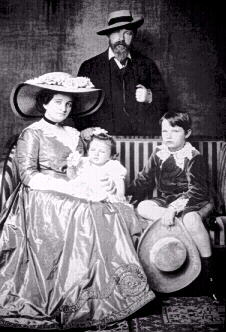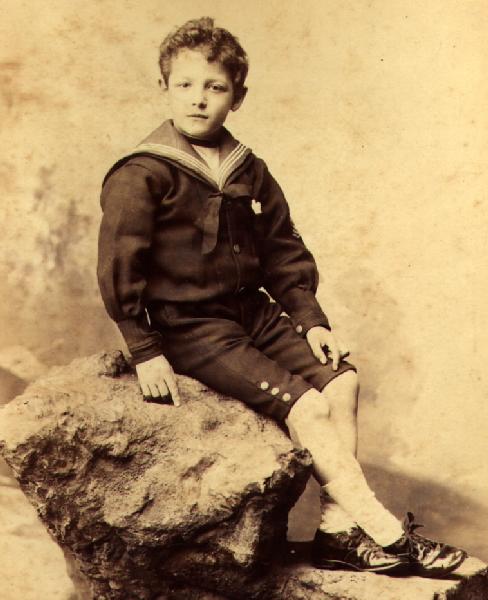 a significant improvement over the confining, formal clothes more
common before the turn of the century.
a significant improvement over the confining, formal clothes more
common before the turn of the century.
Little boys and girls were dressed in
rompers for play. This was
 a significant improvement over the confining, formal clothes more
common before the turn of the century.
a significant improvement over the confining, formal clothes more
common before the turn of the century.
Children's dress was now specifically designed for them and their
active play. There were a large variety of patterns. At last
clothes were simple and childlike.
The small girl's dress covered
her knees and her waistline was placed low. Tots under six wore a
baby style, soft, full frocks shirred to a tiny yoke. Though
schoolgirls wore shirtwaist and skirt there were three popular and
almost uniform styles for that age and under, the
sailor costume or
"middy" blouse, the Russian tunic with pleated skirt and the jumper
dress of navy serge worn over a lingerie blouse or "guimpe."
Accordion pleating designated a party dress. From about 1908 for
everyday wear small girls for play wore bloomers instead of drawers
and petticoats.
The legs of American children were still mostly encased in
long stockings although socks were coming in and being covered by
leggings in winter.
Short pants or trousers worn with knee or
even ankle socks appeared in England for
younger children. Cold weather always called for high, buttoned or
laced shoes and in summer, Oxfords and strap shoes.
Children and adults almost always wore head gear. The older miss wore youthful versions of grown-up
fashions, securing the hat to the hair by means of a long, vicious
looking hatpin instead of the chin-elastic of childhood. Boys generally
wore
sailor hats of various designs. Straw hats held on with elastic
chin straps were still popular. The more modern styles of sailor caps
worn by the various national navies also were adapted for boys.
Boys also began wearing flat caps with peaks.
It was in the hairdo that teen-agers
went fancy free. With either center or
side part most young females wore long curls, flowing hair or long
braids or dressed the front hair into a pompadour and tied it with
a bowknot. And, on the subject of bowknots, wide ribbon was the thing
and often not just one bowknot but two big bows. All this was followed
by the Dutch cut with straight, trimmed bangs. Boys often wore long hair until they
got their first hair cut at 5 years or so. The long Fauntleroy
curls
popular in the 1880s-90s became less common/
Like their sisters, boys also dressed in
sailor suits and the
Russian blouse. A suit resembling the Russian blouse was the
American
Buster Brown tunic with wide starched collar and black
silk scarf. Buster Brown was a popular, small hero of a Sunday
newspaper serial which had quite a following among the youngsters.
The older boys wore knee pants with tunic or short jacket and about
1910, one notes the Norfolk jacket with knickers and white shirt.
Collar and tie accompanied the Norfolk outfit.
Eton collars were considered
esential for proper dress in England. It was customary for
American boys to adopt
long trousers in their teens. During the first
decade long) ribbed, black stockings were worn with high, laced,
black slices, or Oxfords according to season.

Navigate the Historic Boys' Clothing Web Site:
[Introduction]
[Chronologies]
[Style Index]
[Biographies]
[Bibliographies]
[Contributions]
[Boys' Clothing Home]
Navigate the Historic Boys' Clothing Web chronological pages:
[1800s]
[1840s]
[1880s]
[1900s]
[1910s]
[1920s]
[1930s]